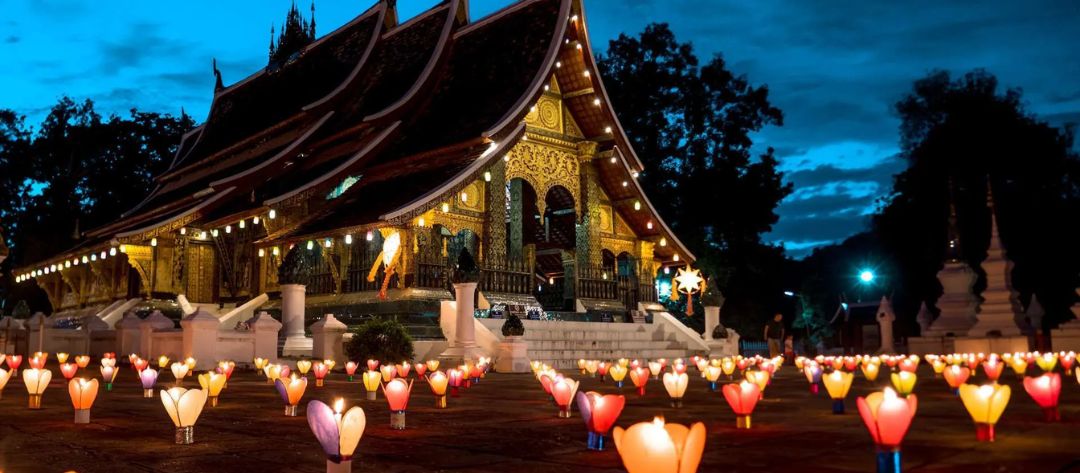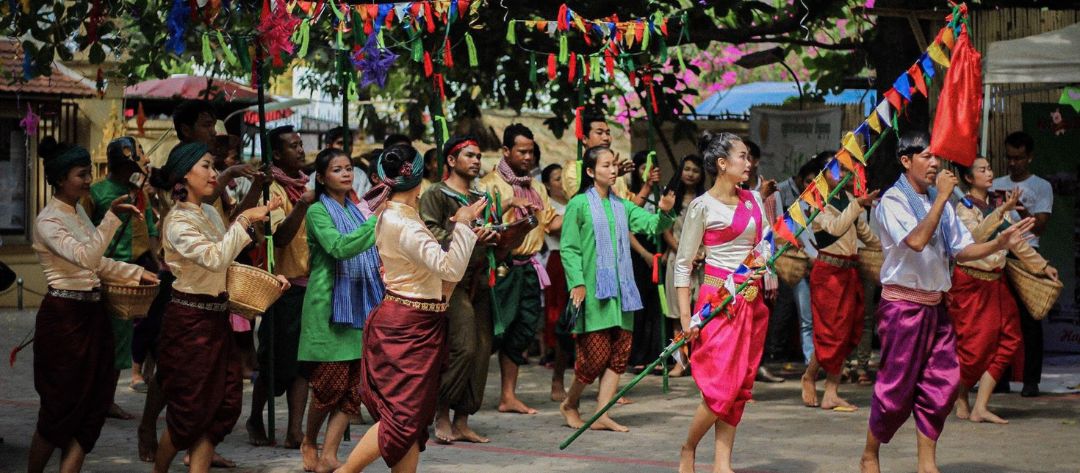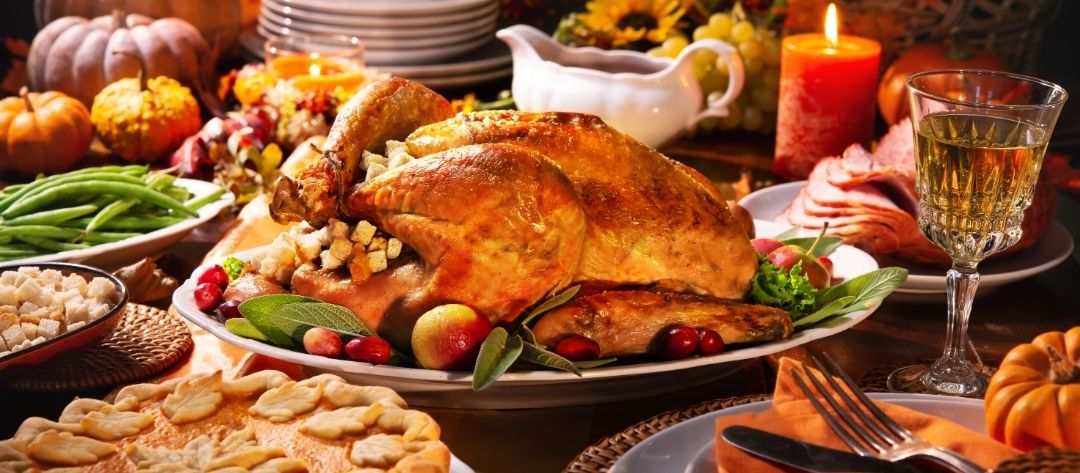You know that feeling when you stumble upon something truly authentic? That’s what happens when you experience Laos festivals. In this country, festivals are the real deal – community celebrations that have been passed down through generations, where locals genuinely welcome you to join in.
We’ve put together a guide to seven festivals that will show you sides of Laos most travelers never see. Some are boisterous affairs where you’ll get soaked in the world’s most joyful water fight. Others are quiet, spiritual experiences that might just change how you see the world. Let’s navigate these celebrations like someone who belongs there, not like you’re peering in from the outside.
Top 7 Traditional Festivals in Laos You Should Not Miss
Experiencing is one of the most memorable ways to connect with the country’s culture, spirituality, and warm-hearted people.
Boun Khoun Khao – Rice Festival
Boun Khoun Khao, or the Rice Festival, is a heartfelt celebration marking the end of the harvest season in Laos. Deeply rooted in agricultural traditions, it honors the rice spirit and shows gratitude for the year’s bounty, while praying for future prosperity and harmony with the land.
This festival is usually celebrated in January, following the Lao calendar, often falling between late January and early February. It takes place mainly in rural areas across Laos, particularly in farming communities of Vientiane Province and beyond.
During the festival, villagers gather at temples with offerings of rice, fruits, and food. Monks lead blessing ceremonies, elders perform the baci ritual, and everyone joins in folk dances, music, and communal feasts, creating a joyful atmosphere of thanksgiving.
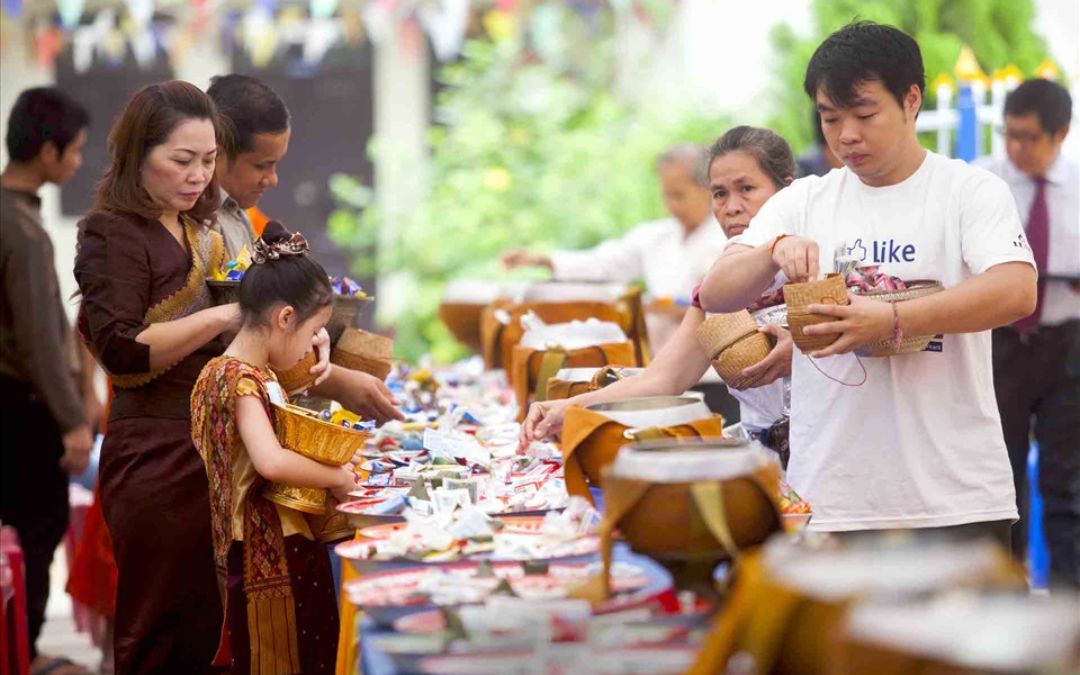
Villagers honor the rice spirit with offerings at Boun Khoun Khao Festival.
Local tips:
- Join a village celebration for authenticity.
- Bring small offerings for merit-making.
- Dress modestly and be ready to share food and drink joyfully.
>> Read More: Surprising Facts About Laos Culture For Curious Travelers
Boun Pi Mai – Laos New Year
When mid-April arrives, Laos bursts into color, laughter, and water as locals welcome the Lao New Year. Pi Mai isn’t just a party – it’s a spiritual renewal, washing away bad luck and inviting blessings for the months ahead. Streets, temples, and homes fill with rituals, joy, and a sense of fresh beginnings.
Celebrated nationwide from April 13 – 16, the liveliest scenes unfold in Vientiane, Luang Prabang, Pakse, and Vang Vieng, where processions and ceremonies attract thousands.
People clean homes, bathe Buddha statues, and splash water on each other in good fun, while elders receive respectful blessings. Parades, sand stupas, dancing, and pageants light up towns as everyone joins the revelry.
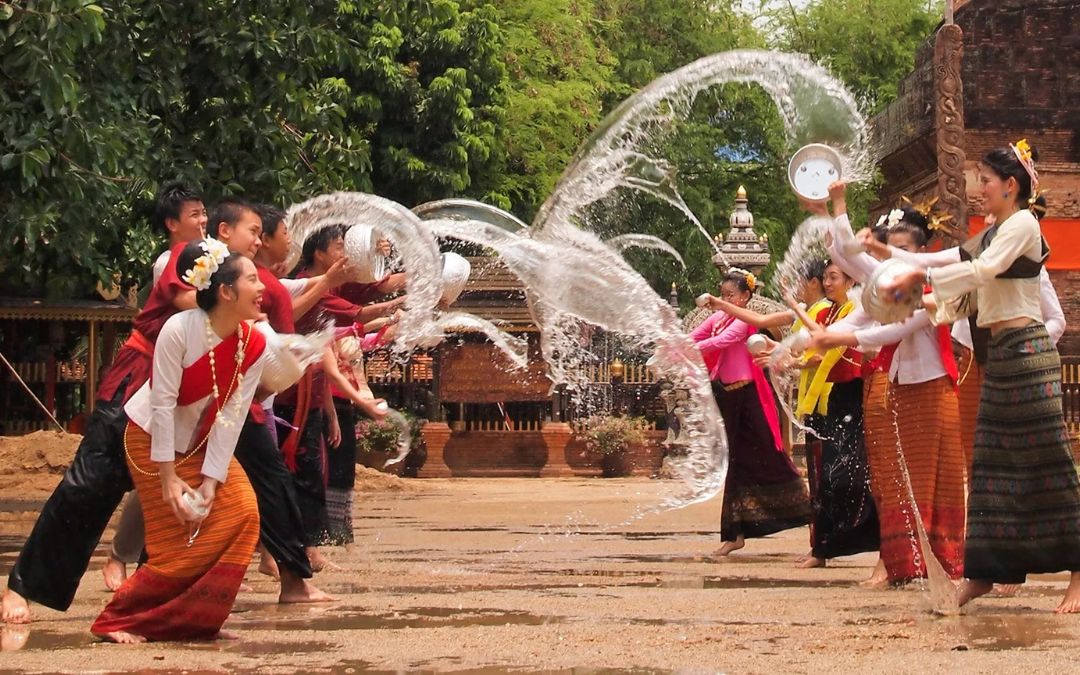
Youths splash water to welcome Pi Mai and bless the new year with joy.
Local Tips:
- Book hotels early, especially in Luang Prabang
- Dress modestly at temples; bring a sarong or scarf
- Protect electronics with waterproof bags – you will get soaked!
- Avoid driving during festivities; streets can be chaotic
Boun Bang Fai – Rocket Festival
In the blazing heat of May, villages across Laos come alive with a raucous mix of noise, color, and skyward explosions. Boun Bang Fai is more than just fun — it’s a rain-calling ritual steeped in ancient fertility beliefs, where rockets awaken the rain gods to bless the fields with life-giving water.
The festival takes place each year in mid-May to early June, just before the rains begin. While celebrated throughout rural Laos, the most electrifying gatherings happen in Vang Vieng, Xaythany District near Vientiane, and Xieng Khouang, where locals and visitors alike flock to the fields.
The day unfolds with giant handmade rockets shooting into the clouds, lively parades, and plenty of dancing, drinking, and laughter. Men in outrageous costumes, comic skits, and playful mayhem turn villages into scenes of unrestrained joy.
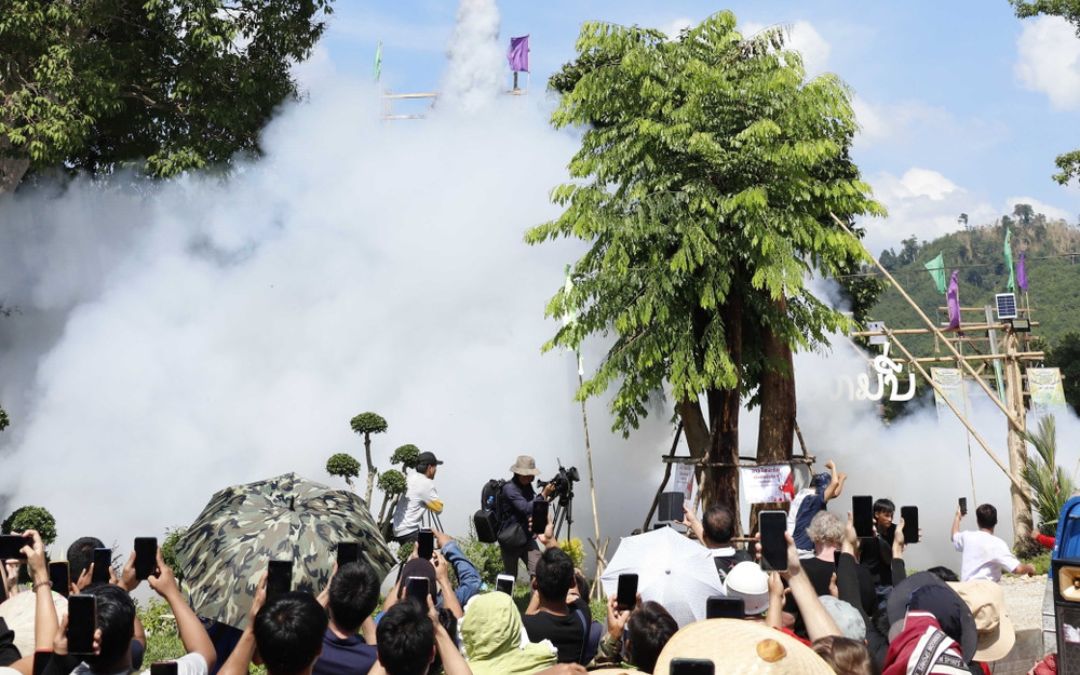
Handmade rockets soar as crowds cheer for rain at the vibrant Rocket Festival.
Local Tips:
- Best spots: Vang Vieng riverbanks or Nason village near Vientiane
- Wear casual clothes — expect mud and smoke
- Be cautious around the rockets; safety rules are loose
- Bring cash for local food and drinks like BeerLao and sticky rice
Boun Khao Phansa – Beginning of Buddhist Lent
Among the most serene and spiritual of all Laos festivals, Boun Khao Phansa marks the start of Buddhist Lent. For three months, monks retreat into temples for meditation, and locals embrace a time of reflection, merit-making, and devotion to Buddhist values.
This quiet yet meaningful festival takes place on the day after the full moon in July or August, signaling the rainy season’s arrival. Major ceremonies are held at temples in Luang Prabang, Vientiane, and Savannakhet, though the atmosphere can be felt throughout the country.
The morning begins with candlelit processions, offerings of food and candles to monks, and prayer ceremonies. Villagers don traditional dress, walk around temples in silence, and make donations to support the monks’ spiritual journey.
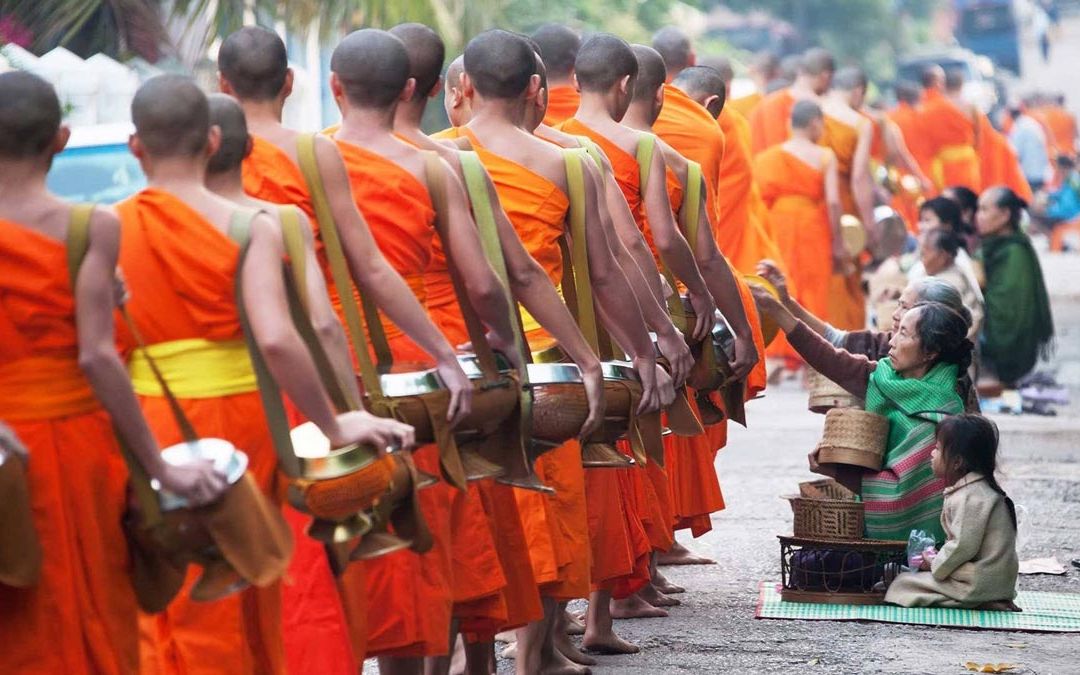
Monks receive alms as locals begin Buddhist Lent with quiet devotion.
Local Tips:
- Arrive early to join candle processions peacefully
- Stay near Luang Prabang’s old quarter for photogenic ceremonies
- Avoid loud behavior; respect the solemn mood
- Sample seasonal treats like khao lam sold outside temples
Boun Haw Khao Salak – Ancestor Festival
One of the most heartfelt Laos festivals, Boun Haw Khao Salak is a time for families to honor their ancestors and departed loved ones. People believe that offerings made on this day reach the spirits, bringing them peace and merit in the afterlife.
This deeply spiritual festival falls on the full moon of the tenth lunar month, usually in September, with ceremonies taking place at temples across Luang Prabang, Vientiane, and Savannakhet. The atmosphere is quiet, respectful, and deeply moving.
Families prepare baskets of food, fruits, and daily necessities, adding notes with names of the deceased, which monks read aloud. Candlelit processions circle temple grounds, while prayers and chants fill the night with a sense of connection and gratitude.
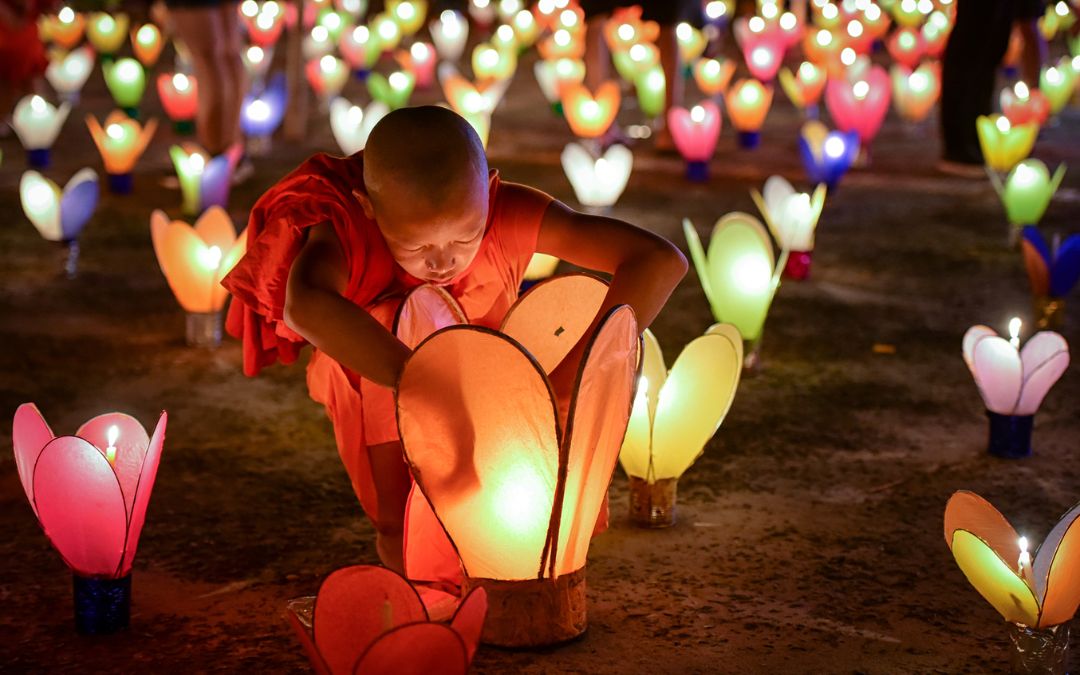
Haw Khao Salak Festival glows as a young monk lights lanterns in remembrance.
Local Tips:
- Visit Wat Ong Teu in Vientiane for an intimate experience
- Dress modestly and bring flowers or incense as offerings
- Join respectfully; avoid disrupting prayers or ceremonies
- Book lodging in advance if visiting Luang Prabang during festival days
Boun Ok Phansa – End of Buddhist Lent
Boun Ok Phansa is the breathtaking finale of three months of spiritual retreat, when monks re-emerge from meditation and the country lights up with gratitude and joy. Known as the Festival of Lights, it’s a magical evening where rivers and temples glow with candles and floating boats.
This enchanting celebration happens on the full moon of the 11th lunar month, usually in October, and is especially beautiful in Luang Prabang, Vientiane, Pakse, and Champasak. The air is cool, and the atmosphere is full of quiet wonder.
As night falls, locals float delicate banana-leaf boats with candles down the rivers, honoring spirits and letting go of misfortune. Streets fill with parades, music, and heartfelt prayers, creating one of Laos’ most memorable nights.
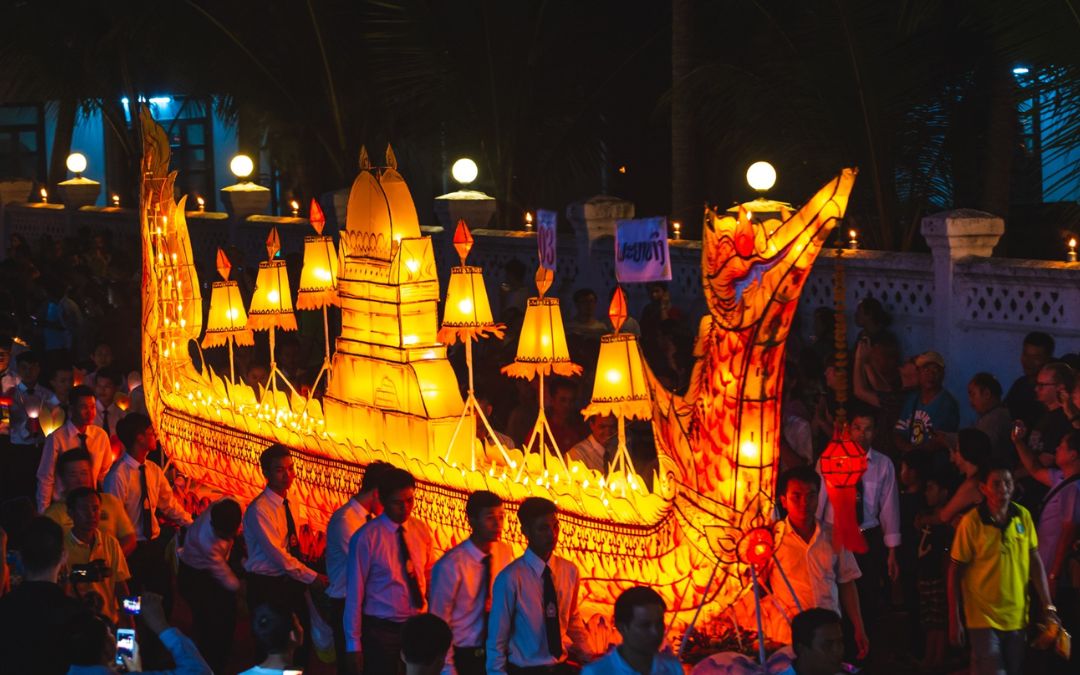
Lantern boats light up the night as Boun Ok Phansa ends with celebration.
Local Tips:
- Best seen at riverside temples in Luang Prabang or Vientiane
- Bring a camera, but be mindful of the solemn mood
- Buy a small handmade boat and join in the ritual
- Dress warmly, as evenings in October can be cool
That Luang Festival – Vientiane’s Grandest Celebration
Every November, during the full moon of the twelfth Buddhist month, Vientiane transforms into a dazzling stage for Laos’ most important religious festival. For three to seven days, thousands gather around the golden Pha That Luang stupa, filling the city with devotion and pride.
At its heart, That Luang Festival honors Laos’ most sacred monument, believed to enshrine a relic of Buddha. It’s a time of unity, where people from across the country and beyond come to pay respects, celebrate their faith, and showcase Lao culture.
Morning almsgiving, colorful parades with wax castles, candlelight processions, and traditional music create a vibrant spectacle. Villagers, monks, and visitors join games, dances, and street feasts as fireworks light up the night.
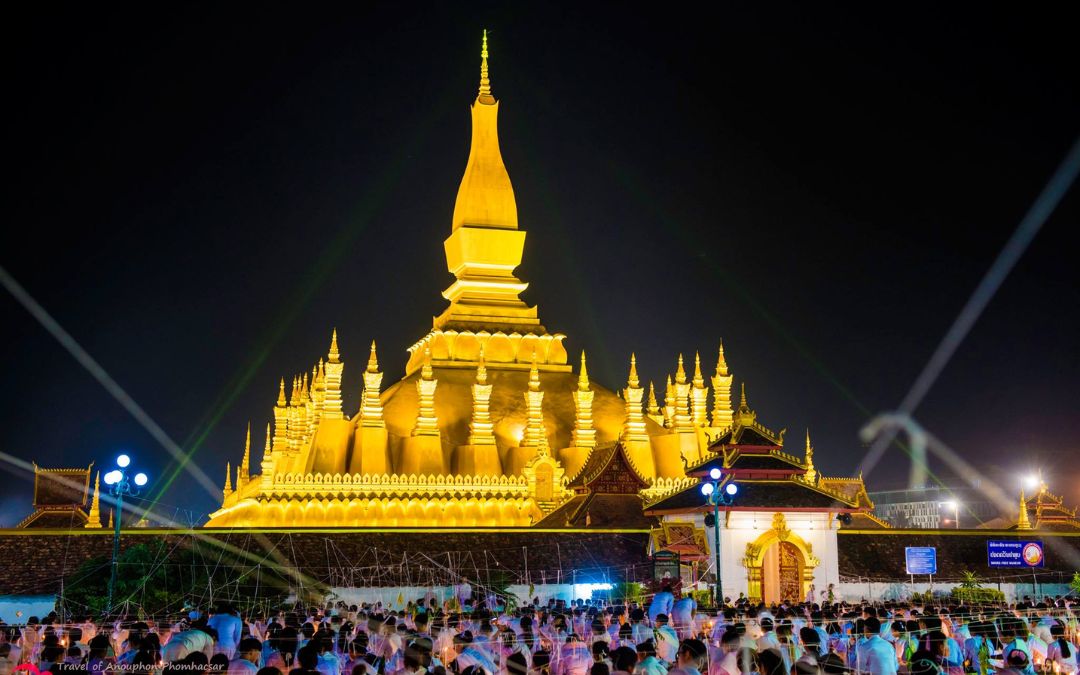
That Luang Festival unites thousands in faith at Vientiane’s golden stupa.
Local Tips:
- Arrive early at Pha That Luang to witness the morning rituals
- Wear traditional Lao attire or modest clothes to blend in
- Try sweet khao nom krok from street vendors nearby
- Stay in central Vientiane to catch processions and evening festivities easily
>> Read More: Where To Visit In Laos For First-time Travelers
How to Plan Your Laos Itinerary Around Festival Dates
When planning your trip around Laos festivals, paying attention to timing, etiquette, packing, and transport will make the experience smoother and more rewarding. Here’s how to prepare like a pro.
When to Book Travel & Accommodation
The busiest months overlap with festival season, from November to February, when the weather is cool and dry. To get the best deals and avoid sold-out rooms, keep these tips in mind:
- Book flights 40–75 days in advance for better prices
- Reserve accommodation early, especially in Luang Prabang during big festivals like Lao New Year or the Festival of Light.
- Consider shoulder months (March–April, September–October) for fewer crowds and lower prices.
- Note that many official festival dates depend on the lunar calendar and are only confirmed a week or two before and follow local tourism pages for updates.
>> Read More: Best Time To Visit Laos For Timeless Charm Exploration
Cultural Etiquette & What to Pack
Laos festivals are deeply spiritual and full of tradition. Showing respect and being prepared will help you feel welcome and avoid awkward cultural faux pas.
- Dress modestly by covering shoulders and knees at temples; women should pack or rent a traditional sinh skirt to participate in ceremonies respectfully and avoid being turned away.
- Always observe what locals are doing during rituals, waiting your turn quietly and mirroring their actions so you don’t unintentionally disrupt the flow of sacred ceremonies.
- Bring light, breathable clothing, a scarf for temple visits, sunscreen, insect repellent, and waterproof pouches to protect valuables, especially during water festivals when everyone and everything gets soaked.
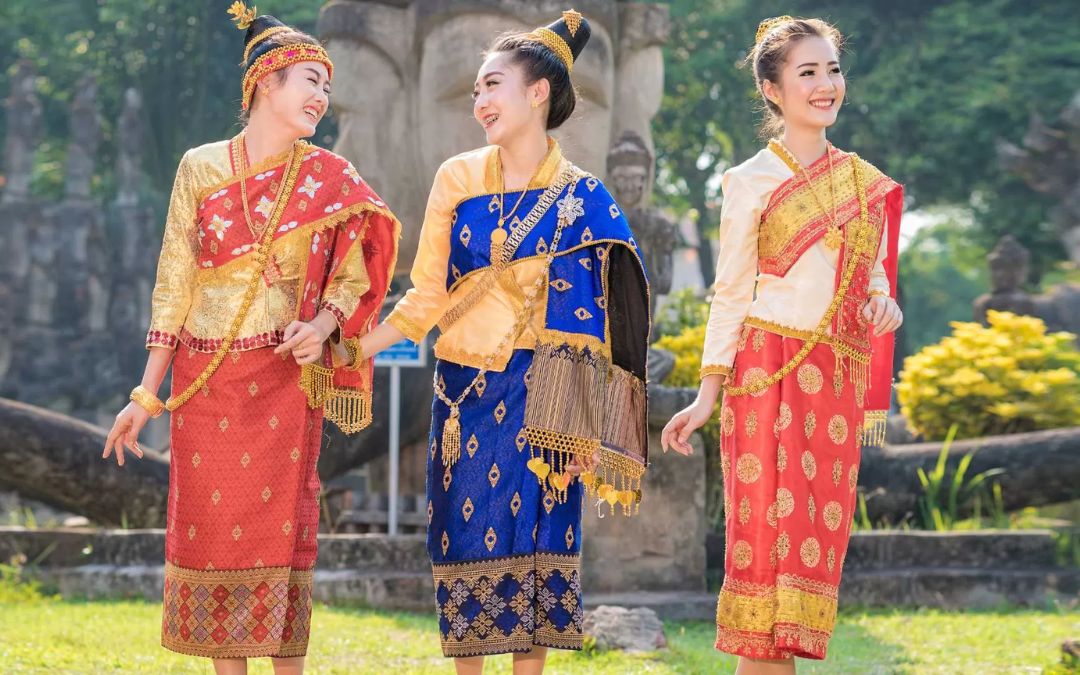
Women wear sinh skirts to honor Laos tradition during local festivals.
Local Transport & Logistics
Reaching Laos festivals often means combining several modes of transport. Each offers a unique experience. Here’s what to expect, and how much you might pay along the way:
- Buses are the most affordable way to travel between cities like Vientiane, Luang Prabang, and Pakse, with tickets typically costing $8–$20, depending on the route and bus type.
- Boats and ferries offer scenic rides on rivers to reach remote villages, costing around $5–$15 per trip, perfect for festival days in riverside towns along the Mekong or Nam Ou.
- Day tours from Luang Prabang bundle transport, guide, and entry fees, starting at about $30–$50 per person, and are a hassle-free option for visiting nearby villages during festivals.
- Private transport, such as hiring a driver or tuk-tuk for the day, is ideal for rural festivals, with rates ranging from $40–$80 per day, offering comfort and flexibility.
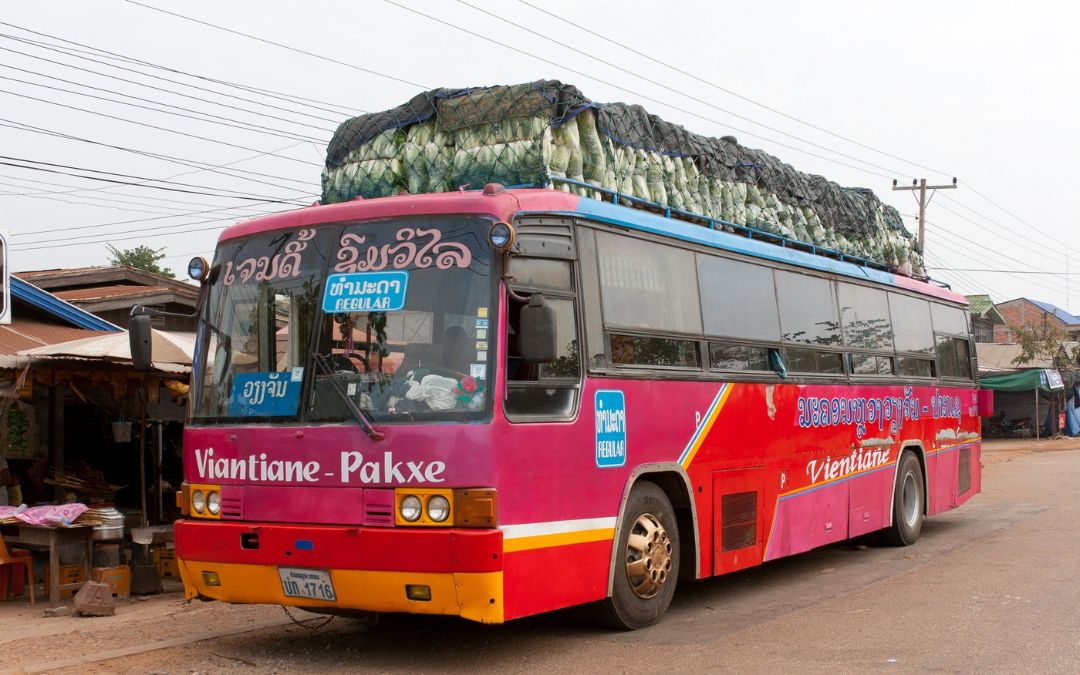
Buses connect the cities and carry both locals and festival goods.
>> See Tour: Laos Family Holiday
Ideal Itinerary: The Very Best of Laos in 12 Days
This thoughtfully designed journey blends breathtaking landscapes, ancient culture, and the vibrant spirit of Laos festivals, offering an authentic experience of the country’s charm.
Day 1: Arrival in Luang Prabang
- Meet your private guide at Luang Prabang Airport, transfer to your hotel, and enjoy some free time to rest and adjust to the laid-back pace of this magical city.
- In the evening, join your guide for a short tour briefing followed by a welcome dinner at a social enterprise restaurant supporting local youth through vocational training.
Day 2: Luang Prabang Heritage Tour
- Visit the bustling Morning Market, then explore serene temples such as Wat Mai and Wat Visoun before stepping into the former King’s Palace to learn about royal Lao history.
- In the afternoon, wander craft villages famous for Saa paper and weaving, then climb Mount Phousi for sunset views over the city before visiting the vibrant Night Market.
Day 3: Pak Ou Caves and Kuang Si Falls
- Rise early to join monks collecting alms in an ancient ritual before visiting the sacred Pak Ou Caves by boat, filled with hundreds of Buddha statues overlooking the Mekong River.
- After lunch, head to Kuang Si Falls where you can swim in turquoise pools, meet rescued bears at a sanctuary, and visit a buffalo dairy farm for ice cream and hands-on experiences.
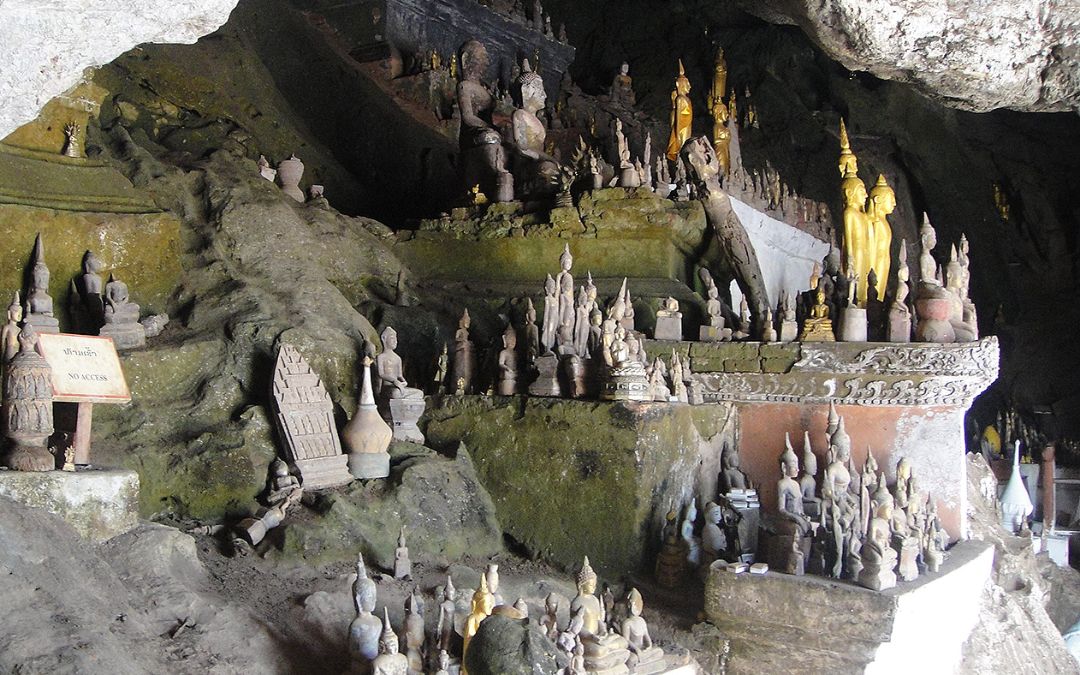
Hundreds of Buddhas fill Pak Ou Caves and overlook the Mekong River.
Day 4: Elephant Experience
- Spend a meaningful day at the Elephant Park Project, learning about conservation and riding an elephant through peaceful forests before visiting the cascading Tad Sae Waterfall nearby.
- Return to Luang Prabang with a deeper appreciation of Laos’ elephants and the ongoing efforts to protect them and their natural habitat.
Day 5: Luang Prabang to Xieng Khouang
- Fly to Xieng Khouang and explore the fascinating Plain of Jars, an archaeological mystery where giant stone jars are scattered across rolling plateaus and peaceful countryside.
- Visit small traditional villages to see local life and crafts before checking in at your hotel in Phonsavanh for a restful evening.
Day 6: Xieng Khouang to Vientiane
- Start the day with a visit to the ruins of the Phuan kingdom and enjoy fresh Lao noodle soup at a lively market before flying to Vientiane in the late morning.
- In the afternoon, tour the striking Patuxai Monument and the inspiring COPE Center to learn about Laos’ ongoing efforts to recover from its war-torn past.
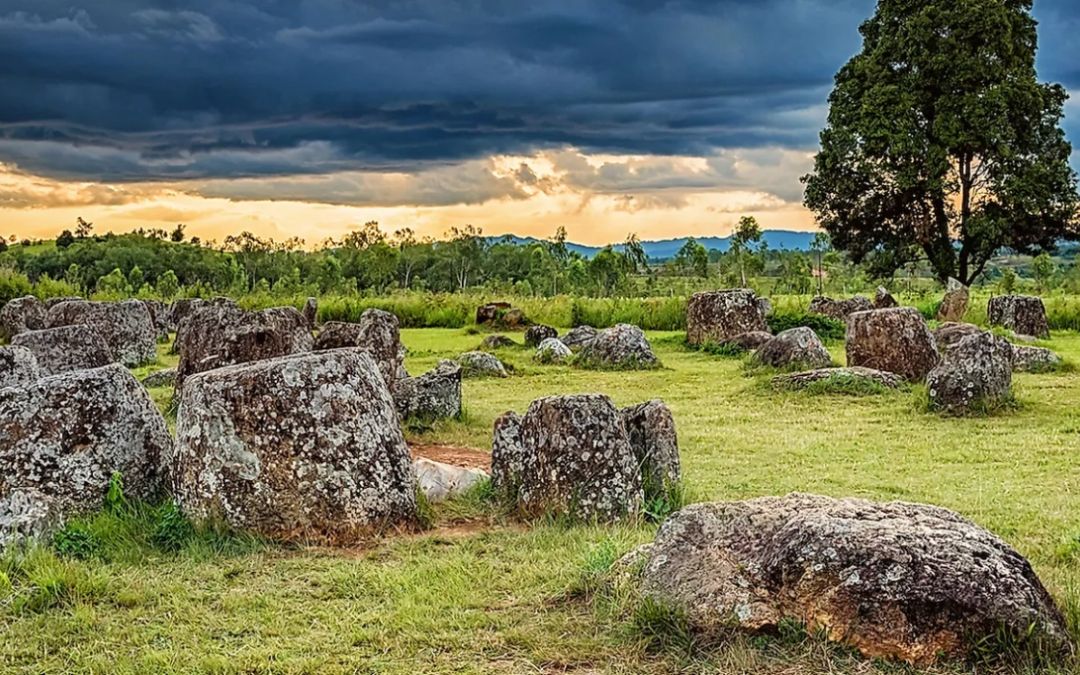
The Plain of Jars displays ancient stone jars across peaceful Lao hills.
Day 7: Vientiane City Tour
- Spend the morning visiting beautiful Buddhist sites including Vat Sisaket, Wat Prakeo, and the golden Pha That Luang, the spiritual heart of the nation.
- Continue to Wat Ong Tue and Wat Si Muang, then shop at Talat Sao market before relaxing along the Mekong riverside with a cold BeerLao at sunset.
Day 8: Vientiane to Pakse and Bolaven Plateau
- Fly south to Pakse and head into the cool Bolaven Plateau, stopping at Ban Katuu village to learn about coffee cultivation and sample fresh brews from the plantation.
- End the day browsing Talat Dao Heung Market, filled with spices, sweets, and handicrafts, before checking into your resort surrounded by lush greenery.
Day 9: Bolaven Plateau to 4000 Islands
- Discover Tad Fane and Tad Yeung waterfalls hidden in rainforest, then journey to the stunning 4000 Islands region, a serene paradise scattered across the wide Mekong River.
- Visit Lippi Waterfall and Ban Hang Khon to spot rare Irrawaddy dolphins before crossing by boat to Done Khone Island for an overnight stay.
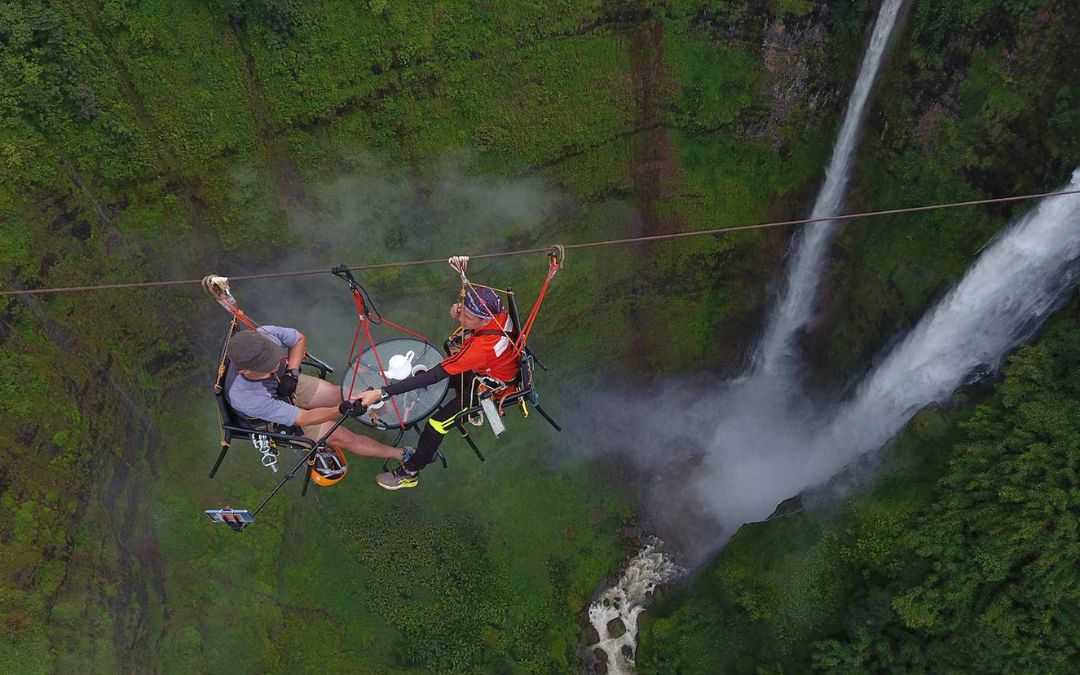
Adventure seekers should visit Tad Fane for thrilling rainforest zipline rides.
Day 10: Done Khone to Champasak
- Trek alongside elephants through rice paddies and jungle, guided by your mahout, before enjoying a hearty lunch with villagers who share their stories and traditional cuisine.
- In the afternoon, explore the mysterious Wat Um Tomo ruins nestled in the forest before arriving in charming Champasak to unwind at your hotel.
Day 11: Wat Phou and Champasak
- Visit UNESCO-listed Wat Phou, a magnificent Khmer temple complex set on a hillside, and climb to its upper shrines while learning about its fascinating Hindu and Buddhist history.
- Spend the afternoon cycling around quiet Champasak streets or relaxing by the Mekong, soaking in the peaceful atmosphere and reflecting on your journey.
Day 12: Departure from Champasak
- Enjoy a leisurely morning at your hotel before lunch, then transfer to Pakse Airport or cross into Thailand to continue your adventure or begin your journey home.
- Leave with lasting memories of stunning landscapes, welcoming people, and a deeper connection to the traditions that make Laos festivals so special.
>> See Tour: The Very Best Of Laos Tour
Experience the Magic of Laos Festivals with Asia Pioneer Travel
From serene candlelit ceremonies to joyful water fights and lively parades, Laos festivals reveal the heart and heritage of this enchanting country. Each celebration invites you to connect deeply with Lao culture and community.
Let Asia Pioneer Travel help you experience these unforgettable moments effortlessly. Our experts will design a journey that aligns with your interests and lets you witness the most authentic festivals up close.
Reach out to Asia Pioneer Travel now and let us curate your unforgettable Laos festival experience.

